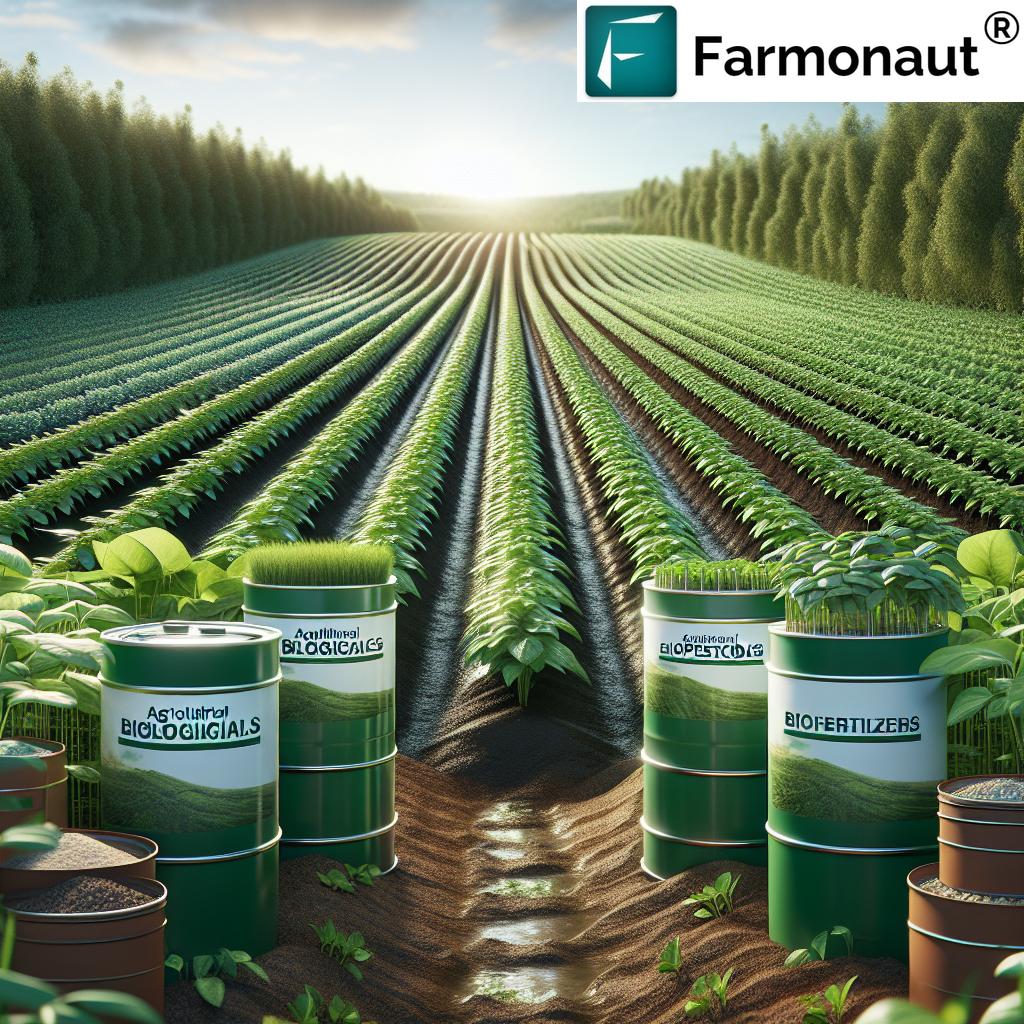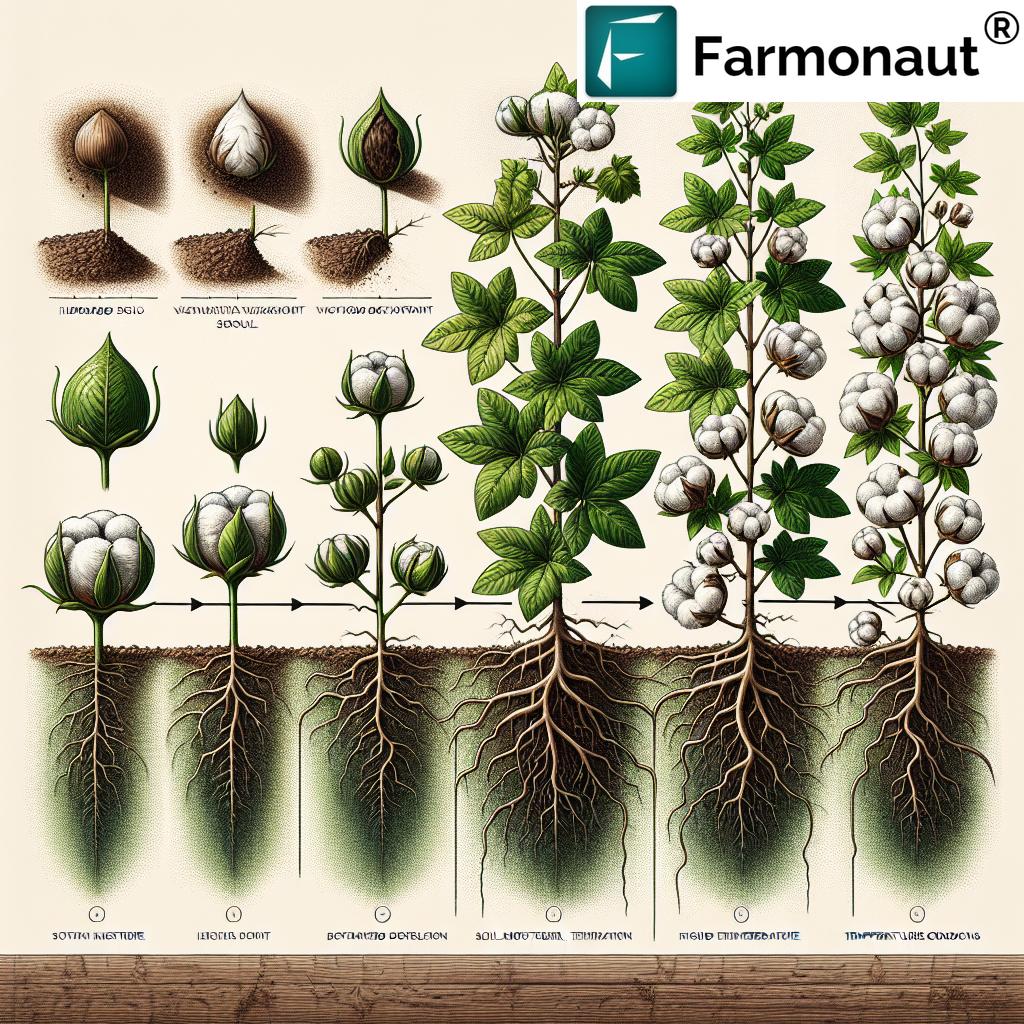Chinaberry, Sugarberry, Chokeberry, Cherry & Soapberry Trees: The Role of Berry Trees in Sustainable Agriculture and Forestry (2025 & Beyond)
“Chinaberry trees can sequester up to 48 kg of CO₂ per year, boosting climate resilience in agroforestry systems.”
Table of Contents
- Introduction: Berry Trees and the Future of Sustainable Agroforestry
- Berry Trees Overview: Focus Species and Sustainable Practices
- Chinaberry Tree: Agroforestry Ally for 2025
- Sugarberry Tree: Biodiversity & Soil Enhancement Leader
- Chokeberry Tree: Nutritional Powerhouse in Sustainable Systems
- Sour Cherry & Cherry Fruit Trees: Balancing Ecology & Economy
- Soapberry Tree: Natural Solutions for Eco-Industry
- Tree Species Comparison Table: Sustainable Agroforestry Benefits
- Berry Trees in Future-Ready Agroforestry: Integration Strategies
- How Technology Empowers Berry Tree Agroforestry
- Farmonaut: Smart Monitoring & Solutions for Agroforestry in 2025
- Climate Resilience and Biodiversity: The True Value of Berry Trees
- Best Practices to Incorporate Berry Trees into Sustainable Lands
- Farmonaut Subscriptions for Sustainable Management
- Frequently Asked Questions: Chinaberry, Sugarberry, Chokeberry, Cherry & Soapberry Trees
- Conclusion: Shaping Sustainable Agriculture & Forestry with Berry Trees
Introduction: Berry Trees and the Future of Sustainable Agroforestry
As sustainable agriculture and forestry practices rapidly evolve to address the global climate crisis, we see a surge in interest around multipurpose tree species. The chinaberry tree (Melia azedarach), sugarberry tree (Celtis laevigata), chokeberry tree (Aronia spp.), sour cherry tree (Prunus cerasus), cherry fruit tree (Prunus avium and related species), and soapberry tree (Sapindus spp.) are becoming central players in agroforestry, conservation, and sustainable economic development.
These unique trees do more than yield fruits—they increase soil health, foster biodiversity, sequester carbon, and support resilient ecosystems and rural livelihoods. As we look towards 2026 and beyond, understanding the ecological, economic, and technological roles of these berry trees is fundamental to shaping sustainable agriculture and forestry systems worldwide.
Berry Trees Overview: Focus Species and Sustainable Practices
The intersection of climate-smart agriculture and eco-friendly forestry revolves around selecting the right trees for the right landscape and agricultural need. The chinaberry tree, sugarberry tree, chokeberry tree, sour cherry tree, cherry fruit tree, and soapberry tree each bring distinctive qualities:
- Chinaberry is prized for rapid growth and natural pesticidal compounds.
- Sugarberry thrives in drought-prone, poor soils and promotes biodiversity.
- Chokeberry has remarkable nutritional and pharmacological potential.
- Sour cherry and cherry fruit trees supply essential foods and react to changing climates with strong resilience.
- Soapberry produces natural, biodegradable products, reducing chemical inputs in agriculture and industry.
By effectively integrating these species within agroforestry systems, we can build more productive, climate-resilient, and economically diverse farms and forests.
“Planting diverse berry trees increases agroforestry plot biodiversity by up to 35%, supporting sustainable and eco-friendly agriculture.”
Chinaberry Tree: Agroforestry Ally for 2025
The Chinaberry Tree (Melia azedarach): Fast Growth for Integrated Systems
The chinaberry tree is a native of Asia and has become widely naturalized globally. Farmers, forest managers, and landowners are focusing on this species for the following key reasons:
- Rapid Growth and Adaptability: It tolerates a range of soil types and establishes rapidly, making it ideal for reforestation and erosion control.
- Windbreak and Shade: Maximizes crop protection and offers livestock cooling in agricultural systems.
- Soil Stabilizer: The deep root systems prevent soil erosion and loss in sloping or flood-prone areas.
- Wood Utility: The wood is valued in furniture making, handicrafts, and other rural livelihoods—expanding diversified income generation opportunities.
- Pesticidal Properties: The bitter fruits and leaves contain bioactive compounds that act as natural pest management agents, presenting an effective alternative to synthetic chemicals in 2025 and the coming years.
- Renewed Attention: Chinaberry’s ability to quickly regenerate and thrive in marginal lands increases its popularity among ecologically minded farmers.

Chinaberry tree agroforestry practices typically involve intercropping with annual crops and other fruit trees, creating synergistic benefits. Its ability to function as a multipurpose tree species supports both ecological balance and rural economic resilience in Asia, North America, and other regions.
Sugarberry Tree: Biodiversity & Soil Enhancement Leader
Sugarberry (Celtis laevigata): Drought-Resilient Hardwood for Restoration
The sugarberry tree, also known as the southern hackberry, is native to North America. This hardwood species is gaining renewed attention for sustainable reforestation and agroforestry systems because it:
- Tolerates Drought & Poor Soils: Thrives in sub-optimal lands where other trees fail, aiding in the rehabilitation of degraded soils.
- Enhances Biodiversity: Attracts birds (e.g., cedar waxwing, mockingbird) and beneficial insects, serving as a keystone species in local ecosystems.
- Supports Crop Health: The tree indirectly benefits nearby crops by hosting insect pollinators and pest predators, reducing the need for chemical inputs.
- Fosters Sustainable Landscapes: Sugarberry’s ability to adapt to changing climate patterns provides resilience for agriculture beyond 2025.
- Fruit Production: Its small, edible fruits serve as an additional food source for wildlife and, in some regions, for local human populations.

In agroforestry systems, the sugarberry tree (Celtis laevigata) is often paired with nitrogen-fixing plants and perennial crops, helping accomplish soil conservation and long-term ecological balance.
Chokeberry Tree: Nutritional Powerhouse in Sustainable Systems
Chokeberry (Aronia spp.): From Hedgerows to High-Value Crops
The chokeberry tree (Aronia spp.) has rapidly evolved from an ornamental shrub to a vital crop in functional agroforestry systems. Key reasons for its rising popularity in 2026 and beyond include:
- Exceptional Antioxidant Content: Fruits are rich in bioactive compounds—especially polyphenols and anthocyanins—making them potent for natural health products and supplements.
- Nutritional & Pharmacological Potential: Studies point to health benefits such as anti-inflammatory, immune-boosting, and cardioprotective effects, driving demand in food and wellness markets.
- Industrial Use & Diversified Farm Income: Chokeberry is incorporated in juice and dietary supplement production, supporting income diversification for farmers operating within agroforestry systems.
- Hardiness: Tolerates drought, cold, and poor soils, thriving even on marginal lands unsuitable for most commercial agriculture.
- Biodiversity Support: Flowers attract bees and butterflies, while fruits feed birds and mammals, establishing vital ecological connections within landscapes.

As farmers and rural communities seek sustainable economic alternatives to monoculture farming, the chokeberry tree stands out for its resilience, nutritional value, and positive environmental footprint.
Sour Cherry & Cherry Fruit Trees: Balancing Ecology & Economy
Sour Cherry (Prunus cerasus), Cherry Fruit Tree (Prunus avium) & Related Species
The sour cherry tree (Prunus cerasus), cherry fruit tree (Prunus avium), and other related species are legendary for their flavorful fruits and their multifaceted roles in agricultural landscapes. Let’s explore how they add value in 2026:
- Food Security & Rural Income: Both sour cherries and sweet cherries are central to fresh fruit markets, jams, juices, and liqueurs, empowering rural economies.
- Ecological Diversity: Their blossoms attract pollinators (bees, butterflies) and the fruits attract birds, helping sustain biodiversity on farms and in forestry systems.
- Climate Resilience: Progressive research and breeding develop climate-hardy cultivars that flourish amid the increased pressure of changing weather and pest loads.
- Integrated Agroforestry: Combining cherry trees with nitrogen-fixing species and perennial ground covers enhances soil health and reduces needs for synthetic inputs.
- Processed Products: Cherries are processed into convenient, high-value food products extending income throughout the year.
Soapberry Tree: Natural Solutions for Eco-Industry
Soapberry (Sapindus spp.): Bioactive Fruits Empowering Green Industry
The soapberry tree is celebrated for an almost magical ecological trait—its fruits contain saponins, which act as natural surfactants for biodegradable cleaning agents. Soapberry contributes to sustainable agriculture, rural self-reliance, and green industry:
- Chemical-Free Products: Provides ingredients for eco-friendly detergents, shampoos, and natural pest control alternatives.
- Climate Resilience: Sturdy and drought-tolerant, ideal for restoring degraded lands and supporting landscape resilience against climate volatility.
- Income Diversification: Opens up channels for value-added products that promote economic development in rural areas, especially across Asia and the Americas.
- Biodiversity & Ecosystem Services: Offers cover and sustenance for a variety of insects, birds, and small mammals.
- Natural Pest Management: Compounds contain bioactive elements that suppress pests, providing farmers with access to alternatives to synthetic agrochemicals.
Adopting soapberry trees in agroforestry systems provides a unique opportunity to meet ecosystem service targets and reduce external chemical inputs across agriculture and rural industry.
Tree Species Comparison Table: Sustainable Agroforestry Benefits
| Tree Species | Botanical Name | Native Region | Key Ecological Benefits | Estimated CO₂ Sequestration Potential (kg/year) | Drought Tolerance | Wildlife Value | Typical Agricultural Uses |
|---|---|---|---|---|---|---|---|
| Chinaberry | Melia azedarach | Asia (widely naturalized globally) | Erosion control, pesticide alternatives, rapid soil cover | 48 | High | Provides shade/cover for birds, deters pests | Windbreak, intercropping, timber/handicrafts |
| Sugarberry | Celtis laevigata | North America | Biodiversity support, soil stabilization, pollinator host | 38 | High | Birds, insects, small mammals | Habitat restoration, reforestation, agroforestry buffer |
| Chokeberry | Aronia spp. | North America (mostly), Europe | Nutritional value, supports pollinators and birds, marginal land use | 28 | Medium | Birds, bees, butterflies | Orchards, integrated hedgerows, value-added fruit |
| Sour Cherry / Cherry Fruit | Prunus cerasus, Prunus avium | Europe, Asia | Supports pollinators, provides food, supports under-canopy crops | 35 | Medium | Birds, bees | Orchards, processed products, intercropping |
| Soapberry | Sapindus spp. | Asia, Americas | Natural detergent/biopesticide, restoration, wildlife cover | 30 | High | Birds, insects | Soap/cleaning products, natural pest control |
Berry Trees in Future-Ready Agroforestry: Integration Strategies
To meet global sustainability goals, farmers and land managers are merging the chinaberry tree, sugarberry tree, chokeberry tree, sour cherry tree, cherry fruit tree, and soapberry tree within progressively complex agroforestry and forestry systems. Here’s how these tree species strengthen sustainable landscapes:
1. Polyculture Design & Ecological Balance
- Intercropping: Planting berry trees among annuals and perennials maximizes space and creates self-regulating soil and pest management systems.
- Layered Farming: Using multipurpose trees at different vertical layers (canopy, sub-canopy, understory) promotes light efficiency, moisture conservation, and weed suppression.
- Diversity Buffers: Hedgerows and boundary plantings with chokeberry and soapberry reduce wind speeds, minimize soil loss, and buffer against climate extremes.
2. Soil Conservation & Carbon Sequestration
- Root Systems: Trees like chinaberry and sugarberry anchor soils and prevent erosion during extreme weather events.
- Organic Enrichment: Leaf litter and root exudates enrich the soil food web, promoting long-term fertility.
- CO₂ Capture: Each focus tree contributes substantially to carbon storage—as shown in the comparison table above.
3. Biodiversity Hotspots & Crop Resilience
- Wildlife Habitat: From nectar in cherry blossoms to fruit for birds, integrating berry trees transforms farms into ecological corridors.
- Pest Control: By boosting predator and parasitoid numbers, these systems naturally suppress pests—minimizing the need for synthetic chemical control.
- Pollinator Support: Flowering periods across species ensure year-round pollinator food sources.
4. Diversified Rural Income Streams
- Timber, Fruit & Natural Products: Value is derived from both harvest and ecosystem services, such as seedling production, honey, timber, fruit, and even saponin extraction.
- Opportunities Beyond 2025: Product innovation—like natural soaps and berry health supplements—enable new revenue for forward-looking farmers.
How Technology Empowers Berry Tree Agroforestry
The integration of technology in agroforestry systems, especially those focusing on chinaberry tree, sugarberry tree, chokeberry tree, sour cherry tree, cherry fruit tree, and soapberry tree, is revolutionizing natural resource management:
- Satellite Monitoring: Platforms like Farmonaut (Web App, Android, iOS) provide real-time field monitoring, enabling precise interventions and early detection of crop stress or tree pest outbreaks.
- AI-Driven Advisory: Artificial intelligence platforms offer tailored recommendations on soil health, pest issues, and adaptive management practices. JEEVN AI is an exemplary system delivering real-time, actionable agricultural guidance for sustainable tree management.
- Blockchain Traceability: End-to-end transparency ensures that berry-based products maintain quality standards and traceable origins. Learn how blockchain powers food and product traceability for consumer trust in 2025 and beyond.
- Resource & Fleet Management: Accurate logistics through tools such as fleet management minimize inefficiency, supporting sustainable harvesting and supply chains.
- Environmental Monitoring: Technology facilitates carbon tracking (carbon footprint monitoring), allowing forest owners to measure and monetize ecosystem services.
Discover Farmonaut’s large-scale farm management tools designed for maximum efficiency and sustainability, whether managing plantations, woodlots, or integrated berry and fruit agroforestry plots.
Farmonaut: Smart Monitoring & Solutions for Agroforestry in 2025
At Farmonaut, we believe in empowering land managers, farmers, and forestry professionals with technology to optimize the management of chinaberry tree, sugarberry tree, chokeberry tree, sour cherry tree, cherry fruit tree, and soapberry tree agroforestry systems:
- Real-Time Satellite Imagery: Visualize your orchard’s tree health, soil moisture, and disease outbreaks with multispectral intelligence—on web or mobile.
- AI Advisory with Jeevn AI: Receive AI-powered, personalized guidance for optimal land stewardship and profitable berry tree cultivation.
- Blockchain Traceability: Maintain full transparency for tree-derived food, fruit, and industrial products.
- Environmental Compliance: Accurately monitor and demonstrate your farm or forest’s climate-smart practices and carbon sequestration.
For those seeking developer access and real-time integrations, our API and API Developer Docs are available for seamless data connectivity.
Climate Resilience and Biodiversity: The True Value of Berry Trees
Integrating the chinaberry tree, sugarberry tree, chokeberry tree, sour cherry tree, cherry fruit tree, and soapberry tree into agriculture and forestry not only advances economic opportunities but also addresses urgent climate and ecosystem challenges:
- Carbon Sequestration: Each species uniquely contributes to drawing down atmospheric CO₂ and building a climate buffer for farms and forests.
- Resilience to Environmental Stress: Drought-tolerant and pest-resistant traits enable landscape recovery after extreme weather.
- Biodiversity Corridors: Planting berry trees as part of wider hedgerow or buffer strip networks increases species richness—supporting everything from bird migrations to beneficial insect populations.
- Reduced Chemical Dependency: Enhanced pest suppression and pollination from berry tree-rich systems diminish input costs, minimize run-off pollution, and enable true regenerative agriculture.
Best Practices to Incorporate Berry Trees into Sustainable Lands
Tips for Successful Planting and Management (2026 and Beyond)
- Site Suitability:
- Assess soil type, water availability, and microclimate before planting the desired tree species.
- Use soil monitoring platforms to match chokeberry and cherry fruit tree varieties to location characteristics.
- Diversity Over Monoculture:
- Blend multipurpose trees—like chinaberry and sugarberry—into mixed plantations, hedgerows, and shelterbelts.
- Layering & Spacing:
- Follow agroforestry spacing norms, considering direct sunlight, air flow, and anticipated tree canopy width.
- Integrated Pest Management:
- Leverage bioactive compounds present in soapberry and chinaberry for on-farm, eco-friendly pest control.
- Valuing Ecosystem Services:
- Include carbon footprinting and biodiversity monitoring to access “green finance” and climate payments.
- Explore Farmonaut’s carbon footprint monitoring services to qualify your project’s carbon reduction and ecosystem impact.
- Continuous Learning & Innovation:
- Stay updated with new resilient cultivars and sustainable cultivation methods by tuning into expert agri-technology content and advisory systems.
Farmonaut Subscriptions for Sustainable Management
Choose the right Farmonaut subscription to enable advanced agroforestry monitoring, crop and tree health analysis, weather prediction, traceability, resource optimization, and compliance for your farm or forestry project in 2026 and beyond:
Frequently Asked Questions: Chinaberry, Sugarberry, Chokeberry, Cherry & Soapberry Trees
1. What roles do chinaberry, sugarberry, chokeberry, cherry, and soapberry trees play in agroforestry?
These tree species increase biodiversity, support soil conservation, enable carbon sequestration, provide natural pest management, supply diverse food products, and offer multiple income streams to farmers and forest managers—driving sustainable agriculture and forestry into 2026 and beyond.
2. How do these berry trees support climate resilience and soil health?
Their deep roots stabilize soils, prevent erosion, and facilitate organic enrichment. Soapberry and chinaberry trees are drought-tolerant, while all species contribute to carbon sequestration—making them climate-resilient assets in agriculture and forestry.
3. What products or markets exist for these trees beyond food?
Beyond fresh fruits, these trees supply wood, crafted goods, saponin-based cleaning agents, health supplements, and contribute to ecosystem service markets such as carbon credits and biodiversity banking.
4. Can these trees reduce the need for chemical inputs?
Yes. By fostering natural pest predator populations, offering bioactive compounds (e.g., saponins, alkaloids), and supporting pollinators, these species help cut down chemical pesticide and synthetic fertilizer use, supporting more regenerative agricultural systems.
5. How does technology improve the management of berry tree agroforestry?
Satellite imagery, AI-based advisories, blockchain traceability, resource management, and environmental monitoring enable precise and sustainable farm or forestry operations targeting these trees, increasing yield, efficiency, and sustainability.
6. Where do these trees typically thrive geographically?
- Chinaberry & Soapberry: Native to Asia, but both now widely naturalized globally—including the Americas.
- Sugarberry: Native to North America.
- Chokeberry: Originates in North America and parts of Europe.
- Sour cherry & Cherry fruit tree: Europe and Asia, now cultivated across temperate climates worldwide.
7. What is the average carbon sequestration potential of each focus tree?
Chinaberry: Up to 48 kg of CO₂ per year; Sugarberry: 38 kg; Chokeberry: 28 kg; Sour Cherry/Cherry Fruit: 35 kg; Soapberry: 30 kg (**see comparative table above**).
Conclusion: Shaping Sustainable Agriculture & Forestry with Berry Trees
As we move into 2026 and beyond, integrating chinaberry tree, sugarberry tree, chokeberry tree, sour cherry tree, cherry fruit tree, and soapberry tree within agroforestry and forestry systems is not just an environmental or ethical imperative—it’s a practical blueprint for sustaining livelihoods, promoting ecological balance, and ensuring food and product security worldwide.
Each of these remarkable berry trees brings unique strengths: resilience to climate extremes, support for biodiversity, alternatives to chemical inputs, and opportunities for economic diversification. By leveraging technological advancements—from satellite monitoring to blockchain traceability—landholders and managers can maximize the productivity and sustainability of their land.
For those seeking the most advanced support in sustainable agriculture and forestry management, Farmonaut offers a platform that combines actionable data, real-time insights, and transparent reporting, enabling smarter and more climate-resilient operations across all rural landscapes.
Let’s promote, cultivate, and preserve these invaluable tree species, and together, create agricultural and forestry systems that nurture both people and the planet into the future.











